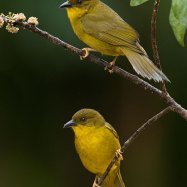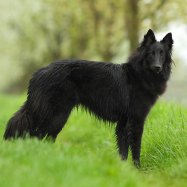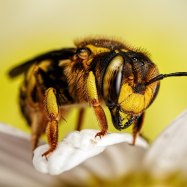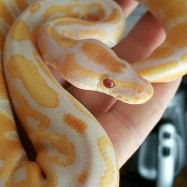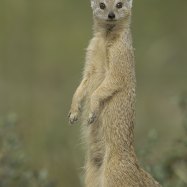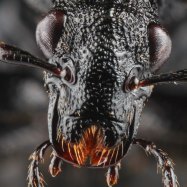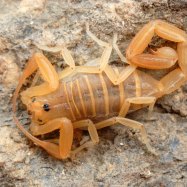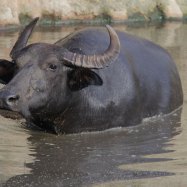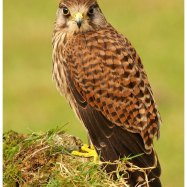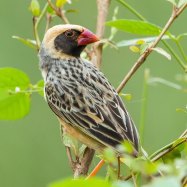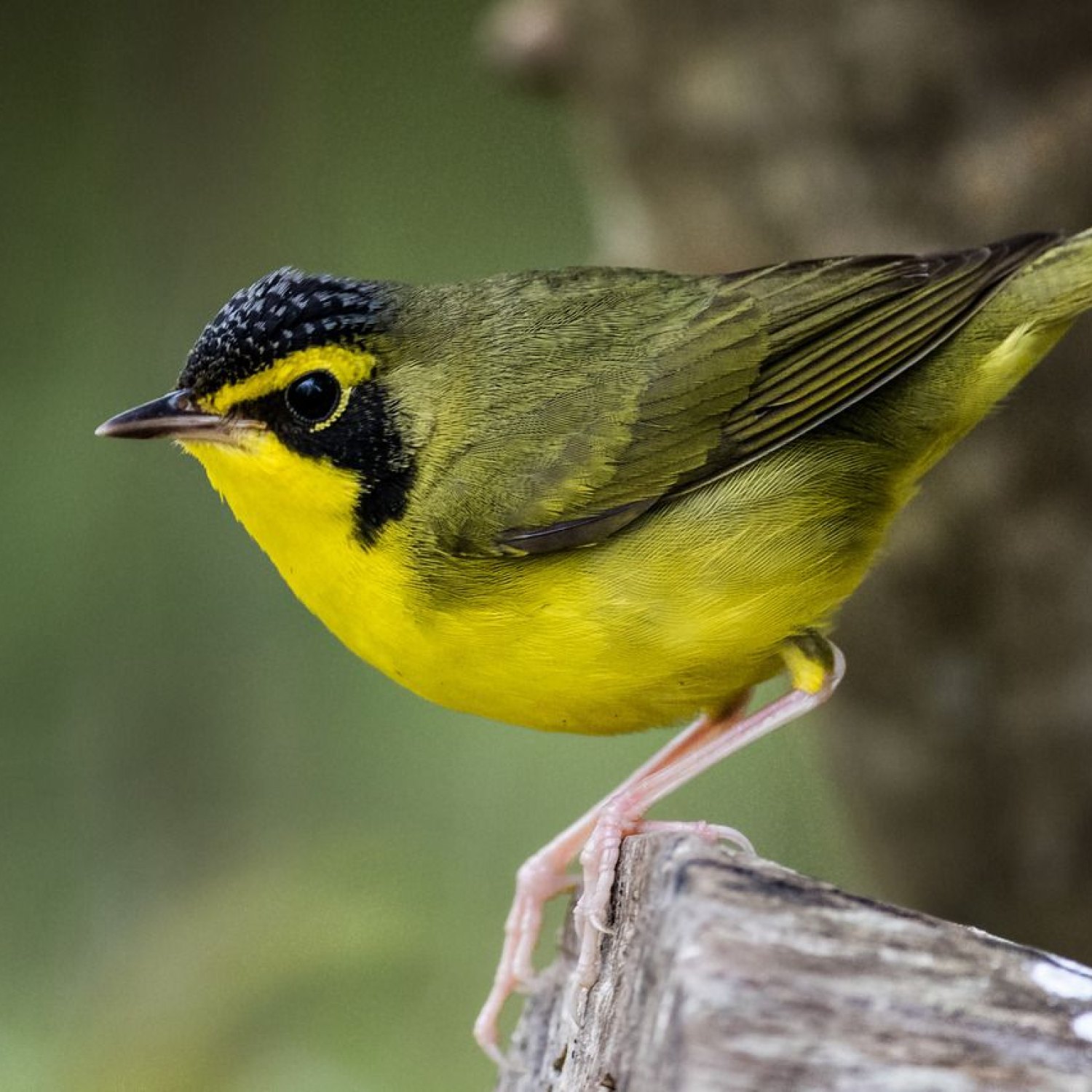
Kentucky Warbler
13 cm
The Kentucky Warbler, a beloved spring visitor to Kentucky and Tennessee, is a small and stocky bird from the Parulidae family. With a length of only 13 cm, this bright yellow songbird is a delight to spot while hiking in the region. #birds #KentuckyWarbler #Parulidae #wildlife
Animal Details Summary:
Common Name: Kentucky Warbler
Kingdom: Animalia
Habitat: Deciduous forests, woodland edges, and shrubby areas
The Enchanting Kentucky Warbler: A Hidden Gem of the Eastern United States
From the dense deciduous forests of the eastern United States comes a small, inconspicuous bird with a surprisingly enchanting presence – the Kentucky Warbler. With a scientific name of Geothlypis formosa, it is also commonly referred to as the "Kentucky Warbler" due to its origins in the state of Kentucky. This charming bird may not be as well-known as its more popular bird counterparts, but it certainly holds its own when it comes to its striking features and unique behaviors. So, let's take a closer look at this hidden gem of the American avian world Kentucky Warbler.A Class of Its Own
The Kentucky Warbler belongs to the kingdom Animalia and the phylum Chordata, making it a vertebrate animal. Within the class Aves, it belongs to the order Passeriformes, which includes birds such as sparrows, finches, and warblers. Its family, the Parulidae, consists of over 100 species of various warblers. So, it's safe to say that the Kentucky Warbler has quite a diverse group of relatives!A Home in the Eastern United States
As its name suggests, the Kentucky Warbler originally hails from the state of Kentucky. However, it can also be found in other regions of the eastern United States, including Tennessee and adjacent areas. This bird is a migratory species, preferring to spend its summers breeding in the eastern United States and then traveling south to Central America for the winter.Habitat and Feeding Habits
The Kentucky Warbler is often found in deciduous forests, woodland edges, and shrubby areas. It prefers to live in dense, heavily wooded areas with thick understory vegetation, which provides an ideal location for building its nest. Due to its small size and secretive nature, it can be difficult to spot this bird in its natural habitat Kowari.In terms of feeding, the Kentucky Warbler is insectivorous, meaning it primarily feeds on insects. Its diet consists of a variety of insects such as beetles, caterpillars, and ants. It forages on the forest floor, using its powerful beak to dig under leaves and in the soil to find its prey.
The Beauty of Nature
The Kentucky Warbler may not have the bright colors and flashy patterns of other birds, but it still manages to captivate with its simple yet striking appearance. Its olive-green upperparts and bright yellow underparts make for a sharp contrast, giving the bird a beautiful and eye-catching look. Its small, stocky body shape only adds to its charm, making it an adorable addition to the lush greenery of its natural habitat.A Hidden Gem
Despite its charming appearance, the Kentucky Warbler is not a commonly seen bird due to its elusive nature and preference for dense habitats. However, its unique behaviors may make it worth the effort to catch a glimpse of this hidden gem. During breeding season, the male Kentucky Warbler is known for its melodious song, which can be heard echoing throughout the forest. While the female may not have a distinct song, she is known for her loud and persistent call when defending her nest.Another interesting behavior of the Kentucky Warbler is its ability to mimic other birds. It is known to mimic calls of other birds, including the Indigo Bunting and the Wood Thrush. This may be a way for the Kentucky Warbler to protect itself from predators by blending in with other species.
A Conservation Concern
Despite its endearing qualities, the Kentucky Warbler is considered a species of conservation concern by the North American Breeding Bird Survey. The population of this bird has been declining due to habitat loss and fragmentation, making it a vulnerable species. Conservation efforts, such as preserving and restoring its preferred habitats, may help prevent further decline of this enchanting bird.In Conclusion
The Kentucky Warbler may not be a household name when it comes to birds, but it certainly has its own unique charm. From its shy and elusive nature to its captivating appearance and interesting behaviors, this small bird is a true hidden gem of the Eastern United States. So, next time you find yourself in its natural habitat, keep an eye out for the Kentucky Warbler – you never know when you may get the chance to see this enchanting bird in action.

Kentucky Warbler
Animal Details Kentucky Warbler - Scientific Name: Geothlypis formosa
- Category: Animals K
- Scientific Name: Geothlypis formosa
- Common Name: Kentucky Warbler
- Kingdom: Animalia
- Phylum: Chordata
- Class: Aves
- Order: Passeriformes
- Family: Parulidae
- Habitat: Deciduous forests, woodland edges, and shrubby areas
- Feeding Method: Insectivorous
- Geographical Distribution: Eastern United States
- Country of Origin: United States
- Location: Kentucky, Tennessee, and adjacent regions
- Animal Coloration: Generally olive-green above and bright yellow below
- Body Shape: Small, stocky
- Length: 13 cm
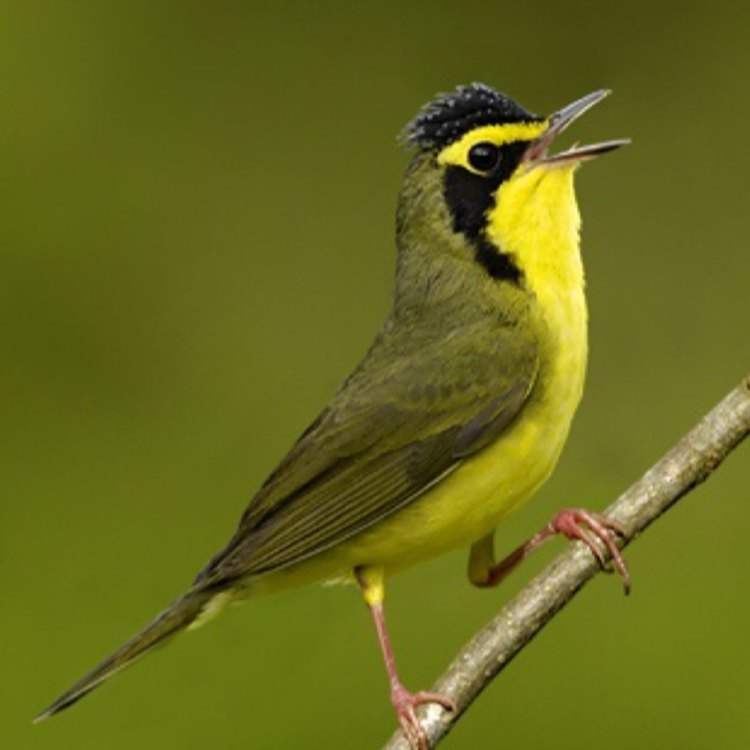
Kentucky Warbler
- Adult Size: Medium-sized
- Average Lifespan: 5-8 years
- Reproduction: Sexual
- Reproductive Behavior: Monogamous
- Sound or Call: Loud, rolling song
- Migration Pattern: Neotropical migrant
- Social Groups: Solitary, territorial
- Behavior: Active and elusive
- Threats: Habitat loss, forest fragmentation
- Conservation Status: Least Concern
- Impact on Ecosystem: Insect control
- Human Use: Birdwatching, eco-tourism
- Distinctive Features: Bold black facial mask, bright yellow underparts
- Interesting Facts: The Kentucky Warbler is named after the state of Kentucky, where it was first discovered in 1811.
- Predator: Snakes, birds of prey
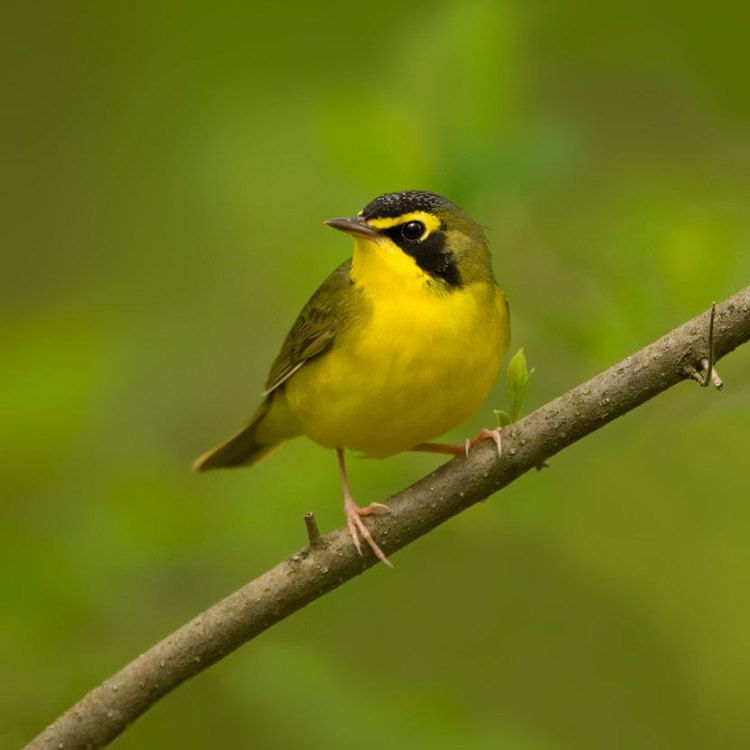
Geothlypis formosa
The Kentucky Warbler: A Hidden Jewel of the Avian World
Kentucky is known for its bluegrass, bourbon, and horse racing, but it is also home to a small, elusive bird that carries the state's name – the Kentucky Warbler. With its bold black facial mask and bright yellow underparts, the Kentucky Warbler is one of the most visually striking warblers in North America. However, this little bird's unique appearance is just one of the many aspects that make it a fascinating species.In this article, we'll dive into the world of the Kentucky Warbler and discover its distinctive features, behavior, conservation status, and impact on the ecosystem PeaceOfAnimals.Com. But first, let's get to know this bird a little better.
The Basics: Size, Lifespan, and Reproduction
The Kentucky Warbler belongs to the family Parulidae, commonly known as the New World warblers. As the name suggests, this is a family of small, insectivorous passerine birds that are mostly found in North and South America. The Kentucky Warbler is considered a medium-sized warbler, growing up to 5-6 inches in length and weighing around 10-13 grams.
In terms of lifespan, the Kentucky Warbler's average life expectancy is 5-8 years. However, some individuals have been known to live up to 10 years in the wild. The exact lifespan of this bird is not well-studied, so these estimates may vary.
The Kentucky Warbler is a sexual species with a monogamous reproductive behavior. This means that each individual mates with only one partner during the breeding season Kit Fox. They typically build cup-shaped nests made of grass and leaves on the ground, although some may also nest in low shrubs or in the forks of tree branches. The female lays 3-5 eggs, which she alone incubates for about 12-14 days. After hatching, both parents take turns feeding the chicks for another 10-12 days until they fledge. This process is repeated 1-2 times during the breeding season.
A Voice That Cannot Be Ignored
One of the most striking features of the Kentucky Warbler is its loud, rolling song. This bird has been described as a "singer" because of its impressive vocal abilities. The male Kentucky Warbler sings to defend his territory and attract a mate, with a song that is often compared to the sound of a bouncing ball. They also have a variety of calls, including a sharp alarm call and a softer, longer contact call.
The Neotropical Migrant
The Kentucky Warbler is considered a neotropical migrant, meaning it breeds in North America and migrates to Central or South America during the non-breeding season. Like many other migratory birds, the Kentucky Warbler's migration pattern is triggered by changes in daylight hours. They typically begin their journey in late August or early September and return to their breeding grounds in April or May.
Solitary Yet Territorial
The Kentucky Warbler is a solitary bird, often found foraging for insects alone. They prefer to stay in areas with dense vegetation, usually on the forest floor or in low shrubs. These areas provide cover and food sources for the warbler, making it an ideal habitat. However, despite their solitary nature, they are highly territorial during the breeding season. The males will vigorously defend their territory from other males, using their loud songs as a warning to potential intruders.
An Active and Elusive Bird
The Kentucky Warbler is a very active bird, constantly hopping around, searching for insects in the dense underbrush. They use their pointed bills to probe through leaves and other vegetation to find their food. This active behavior makes them quite elusive, and it can be a challenge to spot them in the wild. However, with a keen eye and some patience, birdwatchers can catch a glimpse of this fascinating creature.
The Threats to the Kentucky Warbler
Like many other bird species, the Kentucky Warbler faces several threats to its survival. Habitat loss is one of the major threats to these birds, as deforestation and urbanization continue to destroy their natural habitats. As a ground-nesting species, they are also vulnerable to forest fragmentation, which increases their risk of predation.
Climate change is another potential threat to the Kentucky Warbler, as it affects their breeding and migration patterns. Changes in precipitation and temperature can alter insect populations, which can impact the food sources of these birds. This can also lead to a decline in their population or changes in their migration timing.
The Conservation Status of the Kentucky Warbler
Despite these threats, the Kentucky Warbler is currently listed as "Least Concern" on the IUCN Red List of Threatened Species. This classification means that the overall population of this bird is stable, and there are currently no major conservation concerns. However, continued conservation efforts are necessary to ensure the long-term survival of this species.
The Kentucky Warbler's Impact on the Ecosystem
The Kentucky Warbler may be a tiny bird, but its impact on the ecosystem is significant. As an insectivorous species, they play a crucial role in controlling insect populations in their habitat. This helps to maintain the balance of the ecosystem and prevents outbreaks of harmful pests. In addition, the warbler's nesting activity on the forest floor also helps to fertilize the soil, benefiting plants and other organisms in the ecosystem.
Humans and the Kentucky Warbler
The Kentucky Warbler may not be a well-known bird outside of the birdwatching community, but it has a significant impact on eco-tourism in the state of Kentucky. Many avid birdwatchers travel to Kentucky during the breeding season to observe and photograph this stunning bird in its natural habitat. This not only boosts the local economy, but it also raises awareness about the importance of protecting the species and its habitat.
The Legacy of the Kentucky Warbler
In addition to its current significance, the Kentucky Warbler has a long legacy dating back to its discovery in 1811. The bird was named after the state of Kentucky by renowned ornithologist, Alexander Wilson, who first discovered the species. Its name serves as a reminder of the warbler's connection to the state and its place in history.
The Predators of the Kentucky Warbler
Like all birds, the Kentucky Warbler has natural predators, including snakes and birds of prey. However, studies have shown that their elusive behavior and preference for dense vegetation as cover help to protect them from these predators.
Final Thoughts
The Kentucky Warbler may be small in size, but it is a bird with a big personality, unique features, and an important role in the ecosystem. From its bold black facial mask, bright yellow underparts, and loud song, to its solitary, active, and elusive behavior, this bird is truly a hidden jewel of the avian world. As we continue to learn more about this species and their importance in the ecosystem, let us also strive to protect their habitats and support their conservation efforts to ensure their survival for generations to come.
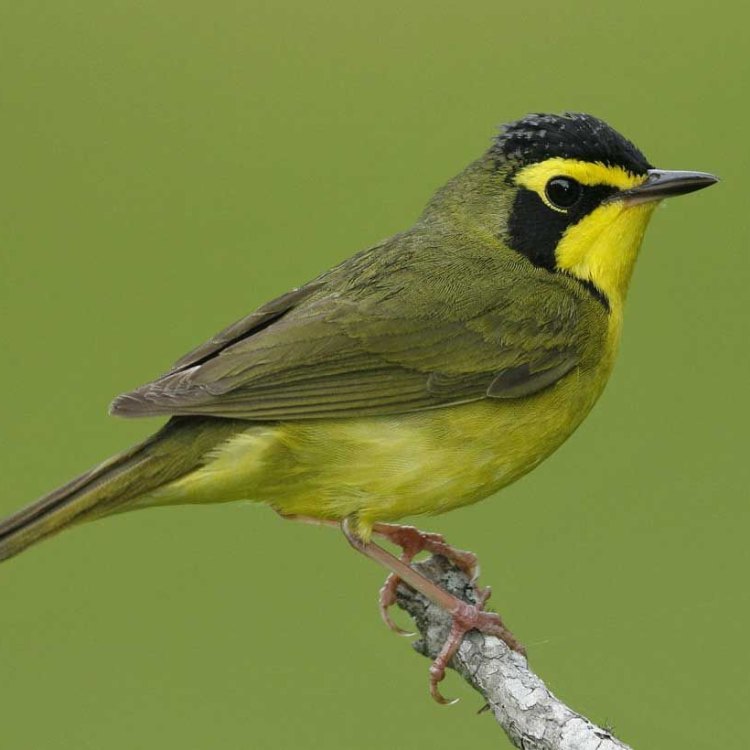
The Enchanting Kentucky Warbler: A Hidden Gem of the Eastern United States
Disclaimer: The content provided is for informational purposes only. We cannot guarantee the accuracy of the information on this page 100%. All information provided here may change without prior notice.


